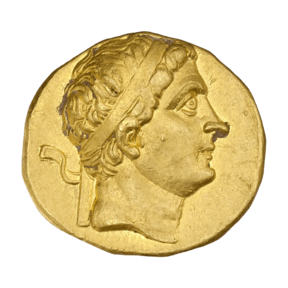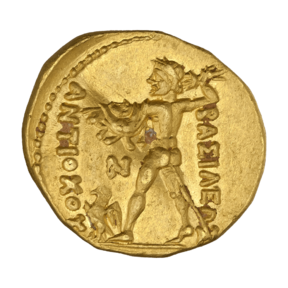Diodotus I facts for kids
Quick facts for kids Diodotus I |
|
|---|---|
| Basileus | |

Gold coin of Diodotus c. 245 BC. The back of the coin says: "ΒΑΣΙΛΕΩΣ ΔΙΟΔΟΤΟΥ" – "(of) King Diodotos". Cabinet des Medailles, Paris.
|
|
| King of Bactria | |
| Reign | c. 255 – c. 235 BCE |
| Predecessor | Position Established |
| Successor | Diodotus II |
| Born | c. 300 BC |
| Died | c. 235 BC Bactria |
| Issue |
|
| Dynasty | Diodotid |
Diodotus I Soter (Greek: Διόδοτος Σωτήρ, Diódotos Sōtḗr; born around 300 BC – died around 235 BC) was the very first Hellenistic king of Bactria. He started out as a satrap (a governor of a province) of Bactria. Around 255 BC, Diodotus made Bactria independent from the Seleucid Empire. This created the Greco-Bactrian Kingdom.
Around 250 BC, Diodotus stopped an invasion of Bactria by Arsaces and his Parthian people. He created many coins and ruled a strong and rich new kingdom. Diodotus died around 235 BC. His son, Diodotus II, became king after him.
Most of what we know about Diodotus comes from his numismatics (coins). We also learn from short mentions by historians like Justin. This is because the main book about his rule, the Parthian History by Apollodorus of Artemita, is now lost.
Contents
How Diodotus Became King
Bactria Before Diodotus
The area of Bactria is in modern-day Afghanistan and Tajikistan. Alexander the Great conquered this region between 329 and 327 BC. He settled many of his soldiers there. After Alexander died in 323 BC, there were many wars. Bactria was mostly left alone during these wars.
However, between 308 and 305 BC, Seleucus I added Bactria to his Seleucid Empire. This empire included other lands Alexander had conquered in Iran and Central Asia. Seleucus I put his son, Antiochus I, in charge of Bactria around 295 BC. Antiochus I made sure the Seleucids had strong control over the area.
Bactria as a Seleucid Province
The region was split into several satrapies (provinces), and Bactria was one of them. Antiochus I built or rebuilt several cities in the Greek style. He also opened mints to make coins. These coins followed the Attic weight standard, a common system for weighing coins.
After Antiochus I became the main ruler of the Seleucid Empire in 281 BC, he put his own son, Antiochus II, in charge of the eastern lands. Antiochus II stayed in this role until he became king in 261 BC.
Diodotus as Governor
Diodotus became the Seleucid satrap (governor) of Bactria during the rule of Antiochus II. The position of Bactrian satrap was very important. Some historians think Diodotus might have married a daughter of Antiochus II later on. This is not certain, though.
Ancient records show that an unnamed Bactrian satrap sent twenty war elephants to Babylon in 273 BC. These elephants joined the Seleucid army fighting against Ptolemaic Egypt. This satrap might have been Diodotus.
Archaeological finds from the city of Ai-Khanoum show that during this time, irrigation systems grew. New public buildings were built, and some military actions took place. These actions were likely raids by nomads from Central Asia. Diodotus was probably involved in these activities as governor.
Bactria Becomes Independent

At some point, Diodotus broke away from the Seleucid Empire. He made his region an independent kingdom. Today, we call this the Graeco-Bactrian kingdom. The Roman historian Justin briefly mentions this event:
Diodotus, the governor of the thousand cities of Bactria, defected and proclaimed himself king; all the other people of the Orient followed his example and seceded from the Macedonians [meaning the Seleucids].
– Justin Epitome of Pompeius Trogus
The exact date when Bactria became independent is not clear. Some historians say it was around 255 BC. Others suggest it was around 245 BC. It might have been a slow process where Diodotus gained more and more power. Or it could have happened suddenly during a time of confusion for the Seleucid Empire.
Archaeological digs show no signs of fighting or destruction during this time. This suggests that the change from Seleucid rule to independence was peaceful.
A Prosperous New Kingdom
When Diodotus became king, he divided his lands into several provinces, each with its own governor. Two of these provinces, Aspionus and Turiva, were on the border with Parthia. Other important settlements might have been provincial capitals. These include Emshi Tepe, Dalverzin Tepe, and Kobadian. It is not clear if Diodotus' main city and mint were at Ai-Khanoum or Bactra.
Ancient writers describe the new kingdom as very rich. Justin called it "the extremely prosperous empire of the thousand cities of Bactria." The geographer Strabo also wrote:
The Greeks who caused Bactria to revolt grew so powerful on account of the fertility of the country that they became masters, not only of Ariana, but also of India... Their cities were Bactra (also called Zariaspa... ), and Darapsa, and several others.
Diodotus remained an enemy of the Parthians throughout his rule. He died around 235 BC, likely from natural causes. His son, Diodotus II, became the next king. Diodotus II later made peace with the Parthians. He even supported them when Seleucus II attacked them. However, Diodotus II was later killed by Euthydemus, who started a new ruling family.
Diodotus' Coins
Before Diodotus became king, there was already a mint (coin factory) in Bactria. It made coins for the Seleucid king. These coins had the king's face on the front. On the back, they showed Apollo, a god important to the Seleucids.
As governor, Diodotus continued to make these coins in the name of Antiochus II. These included gold staters, silver tetradrachms, drachms, and hemidrachms. There were also some bronze coins.
New Coin Designs
Diodotus later introduced new coins. These coins had the head of a man on the front, likely Diodotus himself. He is shown wearing a diadem, a special headband that was a symbol of Greek kings. The face on the coins seems to get older over time, suggesting it was a real picture of Diodotus.
The back of these new coins showed Zeus getting ready to throw his thunderbolt. Zeus was the king of the gods. Diodotus' name means 'Gift of Zeus' in Greek, so this might have been a personal choice. The words on these coins still said 'Of King Antiochus'. This showed Diodotus' power but also kept some connection to the Seleucids.
Later, a small wreath (a circle of leaves) appeared on the back of the coins. A wreath was a Greek symbol of victory. Historians think this might have celebrated a victory over the Parthians. This victory might also be why Diodotus was called soter (savior). Other kings used this title after important victories. This might also be when Diodotus officially took the title of king (basileus).
Bronze Coins
Diodotus also made bronze coins. These coins had the head of Hermes (a messenger god) wearing a petasus hat on the front. On the back, they showed two caducei (winged staffs, a symbol of Hermes) crossing each other. These coins also first said 'Of King Antiochus'. Later, they changed to say 'Of Diodotus'. Many of these bronze coins have been found at Ai-Khanoum.
Diodotus' Family
The only family member we know for sure is his son and successor, Diodotus II Theos. Some historians think he might have had another younger son named Antiochus I Nicator.
One historian, Tarn, suggested that Diodotus had a daughter. He thought she married Euthydemus I and was involved in the killing of Diodotus II. However, there is no clear proof for this daughter.



